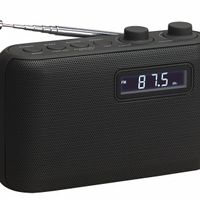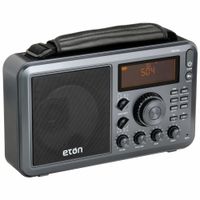Call +(254) 703 030 000 / 751 483 999 / 721 704 777
- Home
- Electronics Batteries
- Electronic Communication Equipment
- Audio Equipment
- Portable Radios
.....Read More
Frequently Asked Questions
What is the best portable radio for AM, FM, and shortwave frequencies?
The Tecsun PL-880 is widely regarded as one of the best portable radios for AM, FM, and shortwave frequencies. It offers excellent sensitivity and selectivity, making it ideal for both casual listeners and radio enthusiasts. The PL-880 features a digital signal processing (DSP) chip, which enhances its reception capabilities and audio clarity across all bands.
The radio is equipped with a large, easy-to-read LCD display that shows frequency, signal strength, and battery status. It also includes a keypad for direct frequency entry, which is convenient for quickly tuning into specific stations. The PL-880 supports single sideband (SSB) reception, a feature that is particularly useful for shortwave listeners interested in amateur radio and other SSB broadcasts.
In terms of audio quality, the Tecsun PL-880 has a built-in speaker that delivers clear and robust sound. It also offers a headphone jack for private listening. The radio is powered by a rechargeable lithium-ion battery, providing long-lasting performance, and it can be charged via a USB port, adding to its portability.
Additional features include a sleep timer, alarm function, and a variety of tuning options such as auto-scan and manual tuning. The PL-880's compact design and durable build make it suitable for travel and outdoor use.
Overall, the Tecsun PL-880 combines advanced features, superior reception, and user-friendly operation, making it a top choice for those seeking a high-quality portable radio for AM, FM, and shortwave listening.
How do portable radios convert signals into music and news?
Portable radios convert signals into music and news through a series of steps involving reception, demodulation, amplification, and sound conversion.
1. **Reception**: The radio antenna captures electromagnetic radio waves transmitted by broadcasting stations. These waves carry audio information encoded in either amplitude modulation (AM) or frequency modulation (FM).
2. **Tuning**: The radio's tuner selects a specific frequency from the multitude of signals received. This is done by adjusting the resonant frequency of the radio's circuit to match the desired station's frequency.
3. **Demodulation**: The selected radio frequency signal is then demodulated to extract the audio information. In AM, the amplitude of the carrier wave varies in accordance with the audio signal, while in FM, it is the frequency that varies. The demodulator circuit retrieves the original audio signal from these variations.
4. **Amplification**: The extracted audio signal is typically weak, so it is amplified using an audio amplifier circuit. This increases the signal's power to a level sufficient to drive the speaker.
5. **Sound Conversion**: Finally, the amplified audio signal is sent to the speaker, which converts the electrical signal into sound waves. The speaker's diaphragm vibrates in response to the audio signal, producing sound that we hear as music or news.
This process allows portable radios to transform invisible radio waves into audible sound, enabling users to listen to broadcasts anywhere within the signal's range.
What are the benefits of a battery-powered vs. hand-crank powered portable radio?
Battery-powered portable radios offer convenience, longer continuous playtime, and ease of use. They typically provide consistent performance without the need for manual effort, making them ideal for extended listening sessions. Battery-powered radios often have more features, such as digital displays and better sound quality, due to the stable power supply. They are also more suitable for situations where physical effort is not feasible, such as for elderly users or in emergencies where conserving energy is crucial.
Hand-crank powered radios, on the other hand, are highly reliable in situations where batteries are unavailable or depleted. They are ideal for emergency preparedness, as they can be powered manually without the need for external power sources. This makes them invaluable during power outages or in remote areas. Hand-crank radios often include additional features like solar panels or built-in flashlights, enhancing their utility in survival situations. They are environmentally friendly, reducing the need for disposable batteries and minimizing electronic waste.
In summary, battery-powered radios are better for convenience and extended use, while hand-crank radios excel in reliability and sustainability during emergencies.
Can shortwave radios receive international broadcasts?
Yes, shortwave radios can receive international broadcasts. Shortwave radio operates on frequencies ranging from 1.6 to 30 MHz, which allows signals to travel long distances by reflecting off the ionosphere. This capability makes it ideal for international broadcasting, as signals can cover vast geographical areas, crossing continents and oceans.
International broadcasters, such as the BBC World Service, Voice of America, and Radio China International, use shortwave frequencies to reach global audiences. These broadcasters transmit news, cultural programs, and educational content, often in multiple languages, to cater to diverse international listeners.
The ability of shortwave signals to travel long distances is due to their interaction with the ionosphere, a layer of the Earth's atmosphere that reflects radio waves back to the surface. This reflection allows signals to "skip" over the horizon, reaching receivers thousands of miles away. The effectiveness of this transmission can vary based on factors like time of day, season, and solar activity, which influence the ionosphere's properties.
Shortwave radios are designed to tune into these frequencies, making them suitable for receiving international broadcasts. They are equipped with features like digital tuning, frequency displays, and sometimes even memory presets to facilitate easy access to various international stations.
Despite the rise of the internet and satellite broadcasting, shortwave radio remains a valuable tool for reaching remote areas, regions with limited internet access, or places where information is censored. It provides a reliable means of communication during emergencies and is favored by hobbyists and enthusiasts who enjoy exploring global broadcasts.
In summary, shortwave radios are well-suited for receiving international broadcasts due to their ability to capture long-distance signals transmitted by major global broadcasters.
How do I improve reception on my portable radio?
1. **Positioning**: Place the radio near a window or an open space to minimize obstructions. Avoid areas with thick walls or metal structures.
2. **Antenna Adjustment**: Extend the antenna fully and adjust its angle. Experiment with different positions to find the best reception.
3. **External Antenna**: Connect an external antenna if your radio has a port for it. A long wire antenna can significantly enhance reception.
4. **Orientation**: Rotate the radio to different angles. Sometimes, a slight change in direction can improve signal clarity.
5. **Elevation**: Elevate the radio by placing it on a higher surface. This can help avoid interference from furniture or other objects.
6. **Interference Reduction**: Turn off or move away from electronic devices like computers, TVs, or fluorescent lights that can cause interference.
7. **AM Reception**: For AM signals, use a loop antenna or a ferrite rod antenna to boost reception. These are particularly effective for AM frequencies.
8. **FM Reception**: For FM signals, use a dipole antenna or a T-shaped wire antenna. These can be homemade or purchased.
9. **Grounding**: If possible, ground the radio to reduce static and improve signal quality.
10. **Battery Check**: Ensure the radio has fresh batteries. Weak batteries can affect reception quality.
11. **Weather Conditions**: Be aware that weather can affect radio signals. Reception might improve or worsen with changes in weather.
12. **Signal Booster**: Consider using a signal booster or amplifier designed for radio frequencies.
13. **Frequency Tuning**: Fine-tune the frequency dial to get the clearest signal. Sometimes, moving slightly off the main frequency can reduce static.
14. **Maintenance**: Regularly clean the radio and its components to ensure optimal performance.
What features should I look for in a portable radio?
When selecting a portable radio, consider the following features:
1. **Frequency Bands**: Look for AM/FM capability. Shortwave and NOAA weather bands are beneficial for global and emergency broadcasts.
2. **Power Source**: Opt for radios with multiple power options such as batteries, solar, hand-crank, and AC adapters for versatility.
3. **Size and Weight**: Ensure it is compact and lightweight for easy portability.
4. **Durability**: Choose a radio with a robust build, preferably water-resistant or shockproof, for outdoor use.
5. **Sound Quality**: Check for clear audio output and adjustable volume controls. Stereo sound is a plus.
6. **Reception Quality**: Look for radios with telescopic antennas and digital tuning for better signal reception.
7. **Display**: A clear, backlit display is useful for reading in low-light conditions.
8. **Preset Stations**: The ability to save favorite stations for quick access is convenient.
9. **Connectivity**: Consider models with Bluetooth or auxiliary input for playing music from other devices.
10. **Additional Features**: Features like a built-in flashlight, alarm clock, or USB charging ports can be useful.
11. **Ease of Use**: Simple controls and an intuitive interface enhance user experience.
12. **Battery Life**: Long battery life is crucial for extended use, especially in emergencies.
13. **Price and Brand**: Consider reputable brands known for quality and reliability, and ensure the price aligns with the features offered.
14. **Reviews and Ratings**: Check user reviews and expert ratings for real-world performance insights.
These features will help you choose a portable radio that meets your needs for entertainment, information, and emergency preparedness.
Are there any portable radios that include emergency features?
Yes, there are portable radios that include emergency features. These radios are specifically designed to be useful in emergency situations, such as natural disasters or power outages. They typically include features like:
1. **Multiple Power Sources**: Many emergency radios can be powered by batteries, solar panels, hand cranks, or USB charging. This ensures that the radio can be used even when conventional power sources are unavailable.
2. **NOAA Weather Alerts**: These radios often have access to NOAA (National Oceanic and Atmospheric Administration) weather channels, providing real-time weather alerts and updates.
3. **AM/FM and Shortwave Bands**: In addition to weather alerts, they usually include AM/FM and sometimes shortwave bands to access a wide range of broadcasts.
4. **Flashlight**: A built-in LED flashlight is a common feature, providing illumination in dark conditions.
5. **Siren or Alarm**: Some models include a siren or alarm function to signal for help in emergencies.
6. **USB Charging Port**: Many emergency radios have a USB port to charge small electronic devices like smartphones, which can be crucial for communication during emergencies.
7. **Durability and Water Resistance**: These radios are often built to be rugged and water-resistant, making them suitable for outdoor use and harsh conditions.
8. **Compact and Lightweight Design**: Portability is key, so these radios are designed to be easy to carry and store.
Popular brands that offer such radios include Eton, Midland, and Kaito. These devices are invaluable tools for emergency preparedness kits, ensuring that users can stay informed and connected when it matters most.

